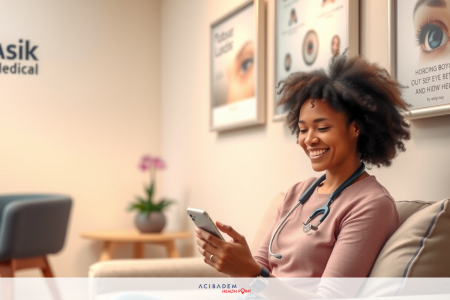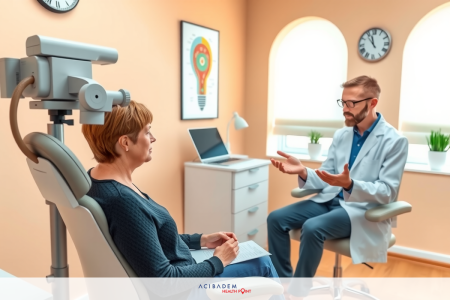Hypertropia: Causes & Treatments
Hypertropia: Causes & Treatments Hypertropia means one eye is higher than the other. It makes the eyes not look in the same direction. It’s a type of strabismus. This condition affects how well you see and how you look. Treating hypertropia is key for better vision and life quality.
The causes of hypertropia can vary and are sometimes complex. It might come from genes, or be linked to brain issues or injury. Knowing what causes it helps in treating the eye problem.
There are different ways to treat hypertropia. The right choice depends on how serious it is and what the patient needs. This can include glasses or prisms, eye exercises, or surgery. Finding and treating it early makes a big difference.
Understanding Hypertropia: An Overview
Hypertropia is a kind of strabismus. It makes one eye look upwards differently. This problem affects how well we see and our daily life. Knowing the signs and who is more likely to get this helps in finding and treating it early.
Definition and Symptoms
With hypertropia, the eyes don’t line up right. This causes double vision or seeing two of the same thing. People may also find it hard to judge depth and often have headaches. Sometimes, one eye looks up by itself, making it hard to see clearly.
Who is Affected by Hypertropia?
Hypertropia affects people of all ages, but kids and older adults often get it. For children, it can make learning and everyday life tough. In the elderly, it might show up after health troubles or an injury. This could cause problems with moving around and an increased falling risk.
It’s important to note the different groups that hypertropia can affect. This shows why getting help early to care for it is crucial. Here’s a table showing how common it is and its effects at different ages:
| Age Group | Incidence Rate (%) | Commonly Reported Symptoms |
|---|---|---|
| Children (0-14 years) | 1-2 | Double Vision, Upward Eye Drift, Headaches |
| Adults (15-64 years) | 0.5-1 | Difficulty with Depth Perception, Visual Strain |
| Older Adults (65+ years) | 1-3 | Balance Issues, Double Vision, Increased Fall Risk |
Knowing about hypertropia and acting quickly can really help. It improves life quality for those living with it.
Causes of Hypertropia
It’s key to know why hypertropia happens for the right treatment. Things like genes, brain problems, and injuries can make your eyes go out of line. Knowing this helps doctors and patients work better for good eye health.
Genetic Factors
Family history might make someone more likely to have hypertropia. If eye issues run in your family, you might see this problem too. Scientists found that changes in genes can be the cause of this, showing how genes and hypertropia are linked.
Neurological Conditions
Problems with the brain can cause hypertropia. Things like cerebral palsy or MS can mess with how your eye muscles work. Doctors should look closely at brain conditions in eye health checkups to catch this issue early.
Trauma and Injury
Hurting your eye can cause hypertropia too. If you get hit in the eye hard or have surgery there, it might hurt the muscles or nerves. Getting quick medical help after an injury is key to keeping your eyes working right.
| Cause | Description | Impact on Eye Health |
|---|---|---|
| Genetic Factors | Inherited genetic mutations | Can cause ocular misalignment in family members over generations |
| Neurological Conditions | Disorders like cerebral palsy and multiple sclerosis | Lead to impaired muscle control and eye misalignment |
| Trauma and Injury | Blunt force impacts or penetrating injuries | Cause damage to eye muscles or nerves, resulting in hypertropia |
Diagnosis of Hypertropia
Diagnosing hypertropia starts with an eye exam by a professional. They check your eyes closely. This helps understand your condition better. Then, they can plan the right treatment for you.
Comprehensive Eye Examination
A full eye exam is central to diagnosing hypertropia. The eye doctor carefully looks at your eyes. They are on the lookout for any issues. Important tests during this process include:
- Visual Acuity Test: It checks how well you see. This helps spot any big sight problems.
- Cover Test: It’s key to finding eye misalignment. The doctor covers one eye at a time to see how the other eye moves.
- Prism Testing: Prisms are used to measure eye turning. This gives accurate info for diagnosing strabismus.
Imaging and Advanced Testing
Advanced tests are also vital for hypertropia diagnosis. They provide a closer look at your eyes. This helps in planning the most accurate treatment.
- Optical Coherence Tomography (OCT): It’s an in-depth test of the retina. This helps pinpoint any eye problems.
- Magnetic Resonance Imaging (MRI): MRIs find issues linked to the brain and eyes. They give a full eye and tissue check.
- Computed Tomography (CT) Scan: CT scans look for eye injuries. They provide detailed 3D images to study the issue further.
| Test | Purpose | Benefits |
|---|---|---|
| Visual Acuity Test | Measures vision sharpness | Identifies visual impairments early |
| Cover Test | Detects eye misalignment | Critical for strabismus diagnosis |
| Prism Testing | Measures eye deviation | Provides precise deviation data |
| OCT | Cross-sectional retina images | Identifies structural issues |
| MRI | Scans for neurological conditions | Comprehensive eye and tissue view |
| CT Scan | Identifies trauma-related causes | Offers 3D imaging |
Hypertropia Symptoms and Impact on Daily Life
Living with hypertropia brings many daily hurdles. People face issues like double vision, headaches, and eye strain. The impact of eye misalignment makes everyday tasks tough for them.
Tasks get harder, like reading, driving, or playing sports. For example, reading might be a struggle for them. This can make them feel tired and upset.
Driving also gets tough because their eyes don’t work together well. This can make it hard to see distances or react quickly to things.
Sports also pose challenges due to daily challenges with hypertropia. It affects how they see and move, making it tough to catch a ball or understand space. Finding a good treatment is key to making life better for people with hypertropia.
The table below shows common symptoms and how they affect daily life:
| Symptom | Daily Impact |
|---|---|
| Double Vision | Trouble with reading and driving |
| Eye Strain | Tiredness with close work |
| Headaches | Uncomfortable after long focus |
| Poor Depth Perception | Struggles in sports and driving |
Knowing about these vision issues and treating them helps a lot. It means less daily challenges with hypertropia. With the right care, people can have less trouble from this condition.
Treatment Options for Hypertropia
There are many ways to treat hypertropia. These include non-invasive options and surgery. The best treatment is based on how serious the condition is and what the patient needs.
Corrective Glasses and Prisms
Corrective glasses and prisms are key in treating hypertropia. They help fix eye alignment using special lenses. This way, they lessen double vision and get the eyes aligned. It’s a simple step that works for lots of people.
Vision Therapy and Eye Exercises
Vision therapy focuses on exercises for eye alignment. It’s great for kids and can fix hypertropia issues. These exercises make eye muscles stronger and improve how the brain uses visual info.
Surgical Interventions
If non-invasive methods don’t work, surgery may be needed. Surgeries adjust eye muscles to better align the eyes. Today’s surgeries are safer and have quicker recovery times. They can offer lasting help for those with hypertropia.
This table shows how treatments compare:
| Treatment Method | Non-Invasive | Benefits | Considerations |
|---|---|---|---|
| Corrective Glasses and Prisms | Yes | Effective for mild cases, immediate vision improvement | Requires regular updates/maintenance, not suitable for all cases |
| Vision Therapy | Yes | Customizable exercises, strengthens ocular muscles | Time-consuming, requires patient compliance and consistency |
| Surgical Interventions | No | Long-term solution, corrects severe alignment issues | Involves surgical risks, recovery time needed |
Recovery and Post-Treatment Care
After treatment for hypertropia, understanding recovery is very important. It’s key to follow post-care guidelines. This ensures your eyes get back on track properly.
Initial Recovery Period
Right after eye treatment, focus on healing and easing any discomfort. You might feel a bit uncomfortable at first. But, this gets better in a few days.
It’s very important to take your meds and follow all directions after surgery. This helps you recover well.
- Medication: Make sure to use antibiotic and anti-inflammatory eye drops as told.
- Rest: Give your eyes a good rest. Avoiding hard activities and strong light is smart.
- Follow-up Appointments: Don’t skip seeing your doctor after surgery. They’ll check how you’re doing and help if you need it.
Long-term Care and Management
After the first recovery, it’s time for long-term care. This means keeping up with checks and eye care for the future.
Here’s what a care plan looks like:
- Periodic Examinations: Regular eye checks are a must. They make sure your eyes stay in good shape.
- Ongoing Vision Therapy: Stick to any eye exercises your doctor gives you. They help keep your eyes strong and aligned.
- Lifestyle Adjustments: Doing things like wearing eye protection and taking breaks from eye strain can really help.
Doing all these steps right helps a lot in the long run. It makes your eye surgery recovery better and keeps hypertropia under control.
Hypertropia: Insights from Acibadem Healthcare Group
Acibadem Healthcare Group is a top provider for those with hypertropia. They use the latest tech and methods for great results. This includes top eye care mixed with focusing on the patient’s needs.
Innovative Treatment Approaches
To give the best care, Acibadem Healthcare Group uses innovative eye treatments. This helps fix hypertropia. They use special surgeries, custom prisms, and vision therapy. All this aims to make eyes work better and life easier for the patients.
Success Stories and Patient Experiences
Their work is shown through happy stories. Many patients talk about seeing better and feeling less eye problems. A table below shares some good results.
| Patient | Initial Condition | Treatment Type | Outcome |
|---|---|---|---|
| Patient A | Severe hypertropia | Customized prisms and vision therapy | Improved alignment, reduced double vision |
| Patient B | Moderate hypertropia | Minimal invasive surgery | Enhanced depth perception, eye strain alleviation |
| Patient C | Mild hypertropia | Comprehensive vision therapy | Marked improvement in vision & quality of life |
This shows how well Acibadem Healthcare Group’s treatments work. They really care about their patients. It brings hope for those with hypertropia.
Preventive Measures for Eye Health
Keeping your eyes healthy is key to safeguarding vision. It helps prevent problems like hypertropia. Using good eye health prevention methods is vital for your health. Let’s look at some important ways to keep your eyes in top shape.
- Regular Eye Examinations: Seeing an eye doctor regularly is important. They can catch eye problems early, like hypertropia, which is key for quick help. It’s good to get a thorough eye check every other year.
- Healthy Lifestyle Choices: Eating right helps your eyes a lot. A diet with vitamins A, C, and E, along with omega-3s and zinc helps with preventive eye care. So, add veggies, fish, nuts, and fruits to your meals.
- Protective Eyewear: The right eyewear stops UVA and UVB rays from harming your eyes. Goggles are also smart for certain activities. Both help keep your eyes safe from UV and injuries.
Now, let’s summarize key steps to avoid eye issues:
| Preventive Actions | Benefits |
|---|---|
| Regular Eye Exams | Spotting and treating eye problems early |
| Healthy Diet | Feeding your eyes the right stuff |
| Protective Eyewear | Blocking UV and avoiding harm |
| Limiting Screen Time | Lessening eye tiredness |
| Proper Lighting | Decreases glare and ups comfort |
Putting these preventive eye care steps in your daily life is very important. It helps make sure your eyes stay healthy for the long run. This way, you lower the chance of having eye issues like hypertropia. By working on eye health prevention, you give yourself the gift of great and clear eyes.
When to Seek Medical Attention for Vision Issues
It’s important to know when to see a doctor for your eyes. Watch for any changes in how you see things. Things like seeing double, constant headaches, squinting, or not seeing clearly mean you should see a doctor. Catching issues early, like hypertropia, can help a lot.
Don’t wait to get help if you’re having eye problems. Serious issues can grow if not treated in time, possibly hurting your vision for good. If you see sudden darkness, feel eye pain, or see flashes, these are serious signs. They need to be checked right away. Quick medical action can solve problems and save your eyesight.
Getting your eyes checked often is wise for good eye health. Regular exams can catch problems early, leading to better care and recovery. Learning when to get help for your eyes keeps your vision and life quality up. When you’re worried about your eye health, always take the safe route and see a doctor.
FAQ
What is hypertropia?
Hypertropia is a kind of strabismus. It makes one eye look up more than the other. This can cause problems like seeing double or finding it hard to judge depth.
What are the main causes of hypertropia?
Genes, health conditions, and accidents can cause hypertropia. These issues lead to eyes not being able to work together well.
How is hypertropia diagnosed?
Doctors diagnose hypertropia with a full eye check. They use tests and sometimes pictures of the eye.
What treatment options are available for hypertropia?
Treatment can include special glasses, exercises, and sometimes surgery. The goal is to make the eyes work better together.
Can hypertropia be treated at Acibadem Healthcare Group?
Yes, Acibadem Healthcare Group can help with hypertropia. They offer different treatment plans, including surgery if needed.
What are the symptoms of hypertropia?
Seeing double, problems judging distance, eye tiredness, and headaches are signs. These can make reading, driving, and playing sports hard.
What should patients expect during the recovery period after treating hypertropia?
After treatment, patients might have check-ups. They will learn how to keep their eyes healthy in the long run.
How can someone prevent hypertropia and maintain overall eye health?
To prevent eye issues, have regular eye checks and live healthily. If you're at risk, use eye protection. These habits help keep your eyes in great shape.
When should someone seek medical attention for vision issues like hypertropia?
If you have ongoing double vision, depth perception troubles, or eye tiredness, see a doctor. Early treatment can stop things from getting worse.
Many patients at Acibadem Healthcare Group are pleased with their hypertropia care. Their vision and life quality improved greatly because of it.













